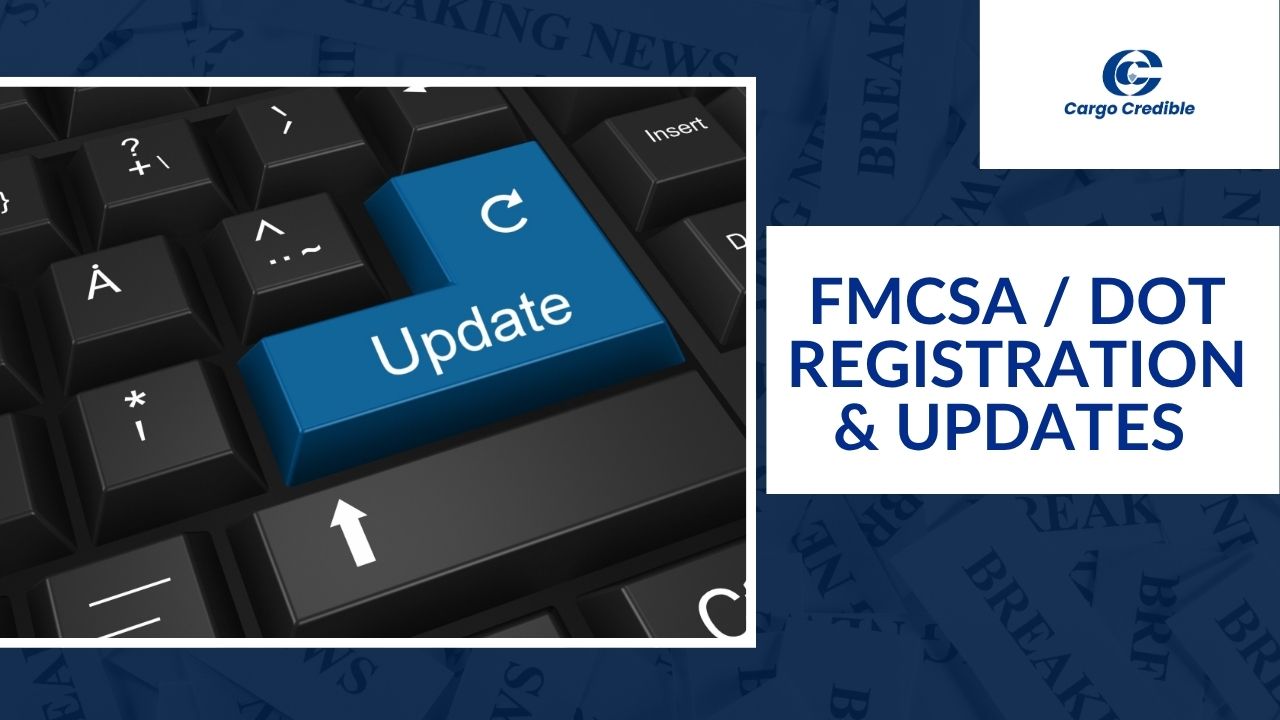FMCSA / DOT Registration & Updates

Introduction
Beginning in 2025, the Federal Motor Carrier Safety Administration (FMCSA) will implement a major overhaul of its registration system affecting all segments of the transportation industry, including carriers, brokers, drivers, shippers, and service providers. The reform centers on replacing the traditional Motor Carrier (MC) number with the USDOT number as the single identifier for all entities starting October 1, 2025. This modernization aims to improve efficiency, reduce fraud, and integrate real-time safety and compliance data. Carriers and brokers will now register and update information exclusively through the FMCSA online portal using secure Login.gov credentials, ensuring improved transparency and data accuracy.
Understanding FMCSA and DOT
The United States Department of Transportation (DOT) oversees transportation systems, while the FMCSA focuses on commercial motor vehicle safety and regulatory compliance. The USDOT number serves as an identifier for tracking a company’s compliance, inspection, and crash records. In contrast, Operating Authority—previously designated by MC, FF, or MX numbers—permits for-hire carriers and brokers to conduct interstate business. Both identifiers are essential for companies engaged in commercial transportation across state lines.
Registration and Authority Requirements
A USDOT number is mandatory for any company operating commercial vehicles that meet FMCSA’s criteria, including interstate operations, passenger transport for hire, or hazardous material carriage. In addition, for-hire carriers and brokers must obtain Operating Authority. These processes involve online applications, proof of insurance, and BOC-3 filings (designation of process agents). FMCSA uses this data to monitor safety performance and ensure companies remain compliant throughout operations.
Registration Process Overview
1. Define your business type (carrier, broker, forwarder, etc.).
2. Gather business information such as legal name, EIN, physical address, and insurance proof.
3. Apply for a USDOT number via the Unified Registration System (URS); issuance is usually instant once approved.
4. Apply for Operating Authority if for-hire, including a $300 fee and required filings.
5. Complete the New Entrant Safety Audit within 12 months of beginning operations.
6. File biennial updates (Form MCS-150) and maintain ongoing compliance.
Failure to complete updates can result in USDOT deactivation and penalties.
Recent and Upcoming FMCSA Regulatory Updates
1. FMCSA Clearinghouse – A centralized database tracking CDL driver drug and alcohol violations. Carriers must perform pre-employment and annual queries with driver consent.
2. Entry-Level Driver Training (ELDT) – Requires all new CDL drivers to complete training from FMCSA-approved providers.
3. Drug & Alcohol Testing – FMCSA now allows oral fluid testing, improving integrity and reducing fraud.
4. Speed Limiter Rulemaking – Pending regulation may mandate speed-limiting devices on heavy commercial vehicles.
5. Insurance Minimums – FMCSA is considering raising insurance requirements for both brokers and carriers, impacting small operators and overall freight costs.
Core Compliance Obligations
• Biennial Update: Every entity must file Form MCS-150 at least every two years. Failure to do so may cause USDOT number deactivation and civil penalties.
• Drug & Alcohol Policy: Carriers must maintain written policies and participate in random testing via a consortium.
• Heavy Vehicle Use Tax (HVUT): Required annually to maintain registration.
• Process Agent (BOC-3): Mandatory filing designating representatives in every state for legal service.
• Insurance Maintenance: Continuous coverage must be maintained and reported to FMCSA to keep authority active.
FMCSA Modernization and System Integration
The FMCSA modernization project consolidates registration and compliance systems into one unified portal. This update includes identity verification, real-time data validation, and electronic-only transactions. As of September 30, 2025, all payments must be electronic—paper checks will no longer be accepted. Future phases will eliminate separate MC/FF numbers entirely, replacing them with USDOT-based authority suffixes. Multi-Factor Authentication (MFA) is now required for portal access.
Key Milestones and Compliance Deadlines
• January 20, 2025 – FMCSA Portal integration with MFA.
• Early 2025 – Launch of registration modernization (Phase 1).
• Mid-2025 – Implementation of expanded identity verification and business proofing.
• September 30, 2025 – Paper payment acceptance ends.
• 2026 – Full modernization rollout; MC/FF identifiers phased out.
Impact by Stakeholder Group
Carriers/Drivers: Must maintain active USDOT numbers, perform biennial updates, and adapt to portal requirements.
Brokers/Shippers: Should update verification systems and contract language to reflect USDOT-only identification.
Service Providers: Compliance firms, software vendors, and insurers must train staff and clients on the new portal and rules.
Researchers/Journalists: Should track modernization impacts on safety metrics, fraud reduction, and public data transparency.
Looking Ahead: 2026 and Beyond
FMCSA’s modernization initiative represents a major digital transformation of the transportation regulatory system. By integrating USDOT-based identification, automated fraud detection, and AI-supported data monitoring, the system aims to increase transparency and efficiency across all freight operations. Future enhancements will streamline compliance renewals through the Unified Carrier Registration (UCR) system and provide modernized access to public safety and compliance data.
Comments (0)
- No comments yet.